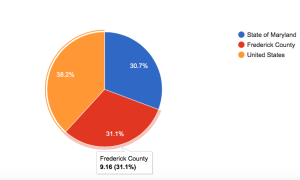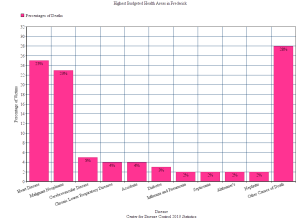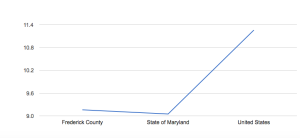By Logan Samuels
The Frederick County Board of Health and Mental Hygiene wants to focus on treatment and research for specific health issues, but budgeting for the public health system prevents this.

Frederick County Health Officer Dr. Barabara Brookmyer explained that
a hot topic issue in Frederick is the suicide rate. For the last 12 years, Frederick County has had a higher suicide death rate than the state.
Henry Westray, Jr., the former chair of the Governor’s Commission on Suicide Prevention, said that Governor Martin O’Malley established an executive order to focus on suicide awareness and prevention as a severe health issue in 2009. For three years, the Governor’s Commission on Suicide actively fought to establish services, hotlines, plans, support groups, and advocacy groups for at-risk groups.
There are various Maryland based foundations and groups that focus on suicide prevention and intervention like the Mental Health Association of Maryland, the National Alliance on Mental Illness: Maryland and the American Foundation for Suicide: Maryland.
O’Malley planned to work in conjunction with the Maryland Public Health System through the Mental Hygiene Administration, but public funding was not available in order to implement a course of action. Due to a lack of funding, suicide is still a major issue in Frederick County today.

Brookmyer said that she is concerned that many Frederick citizens lack trust in the public health system due to the shortage of federal funding the county receives for disease treatment and prevention.
As Frederick County gains popularity and the area continues to flourish, more citizens are working high-stress jobs and are at a higher risk of depression and suicide. However, even as the population continues to grow, public health funding is not being changed to meet the new statistics and issues within the county.
According to Department of Health and Mental Hygiene Director of Communications Christopher Garrett, grants given to hospitals are specific to certain issues determined by the state and federal government and might not align with the concerns within the county, like suicide.
In Frederick County, hospitals like Frederick Memorial Hospital rely on funding from both the state and national government. This funding helps determine what action can be taken toward preventing, educating and treating a variety of diseases.
Dr. Barbara Brookmyer said that the issue stems from altering perspectives of what the biggest health issues are in Frederick.
“When someone says, what are the biggest problems, there are a number of ways to define that,” Brookmyer said, “Does it affect the greatest number of people? Maybe 100 people sneeze, but that isn’t a priority. But if 100 people sneezed and died, then it’s an issue. What’s the number effected and what kind of a dire impact does it take on lives?”
As Brookmyer explains, many funded health issues are the illnesses that affect the largest group of people; however, a disease cannot just be prevalent and popular amongst a community. Funding is constituent on the ability to cure the disease or make an impact on the community.
There is controversy to the approaches different organizations take to determine what the biggest health issues are. The primary focus is targeting an issue that is common with a large negative impact and zeroing in on that disease.
Brookmyer said that it is important to take into account if one group fares worse than another, if statistics differ, and if results vary between different populations. It must be determined if there is anything that can be done to combat the disease or if it is not worth trying to tackle.
However, according to Director Kristi Pier of the Maryland Center for Chronic Disease Prevention and Control of the Department of Health and Mental Hygiene, the top three budgeted illnesses do not include anything related to suicide or mental health. The government funded the 2016 budget as determined by the federal level of the Centers for Disease Control and Prevention.

Pier said that the chronic disease budget focuses on three major areas with its federal funding.
For the 2016 year, $3.5 million will go towards heart disease and stroke prevention as the top health priority.
The second highest funding will go to diabetes prevention and control at $2.8 million. The third highest funding will be $1.3 million for nutrition, physical activity and obesity prevention.
Brookmyer agrees that top funding should go towards heart disease, as there are approximately 166 heart disease cases per 100,000 Frederick County residents. However, the top three funded diseases do not include funding for cancer, which comes in slightly under heart disease with 151 cases per 100,000 residents.
Though federal funding does not cover cancer, Dr. Brookmyer said that Frederick County recognizes cancer as a priority and has funding through a tobacco company settlement from 15 years ago. This restitution money is put towards prevention activities, screenings, treatments and awareness, but once the money runs out from the fund, there will be no budget for these resources.
Though federal funding does not cover cancer, Dr. Brookmyer said that Frederick County recognizes cancer as a priority and has funding through a tobacco company settlement from 15 years ago. This restitution money is put towards prevention activities, screenings, treatments and awareness, but once the money runs out from the fund, there will be no budget for these resources.

Brookmyer said that cancer is a common illness within the county, but its numbers are not particularly higher than other counties or states. While funding for cancer would be ideal, the particular issue that needs recognition is mental health.
Dr. Brookmyer said that when it comes to mental and behavioral health, a large percentage of the population will have a mental health condition at some point in their lifetime that could benefit from professional treatment. However, there is currently no state funding for this resource.
In Frederick County, mental health issues are on the rise. One in 10 surveyed adults under the Frederick County data collection for mental health surveying reported having between eight and 29 days within the last 30 days where they admit to poor mental health and behavior.

Many of these people do not have access to insurance or income or cannot afford co-pays and deductibles within their insurance program to seek medical help for mental health.
Dr. Brookmyer said she is concerned with the stigma against mental health and wants to make it the forefront of discussion when determining the new budget for 2017 this summer.
“There is no funding for mental and behavioral health and there is a stigma we have to overcome,” Brookmyer said, “With more funding, we could increase community awareness…but it’s so difficult to make that happen.”